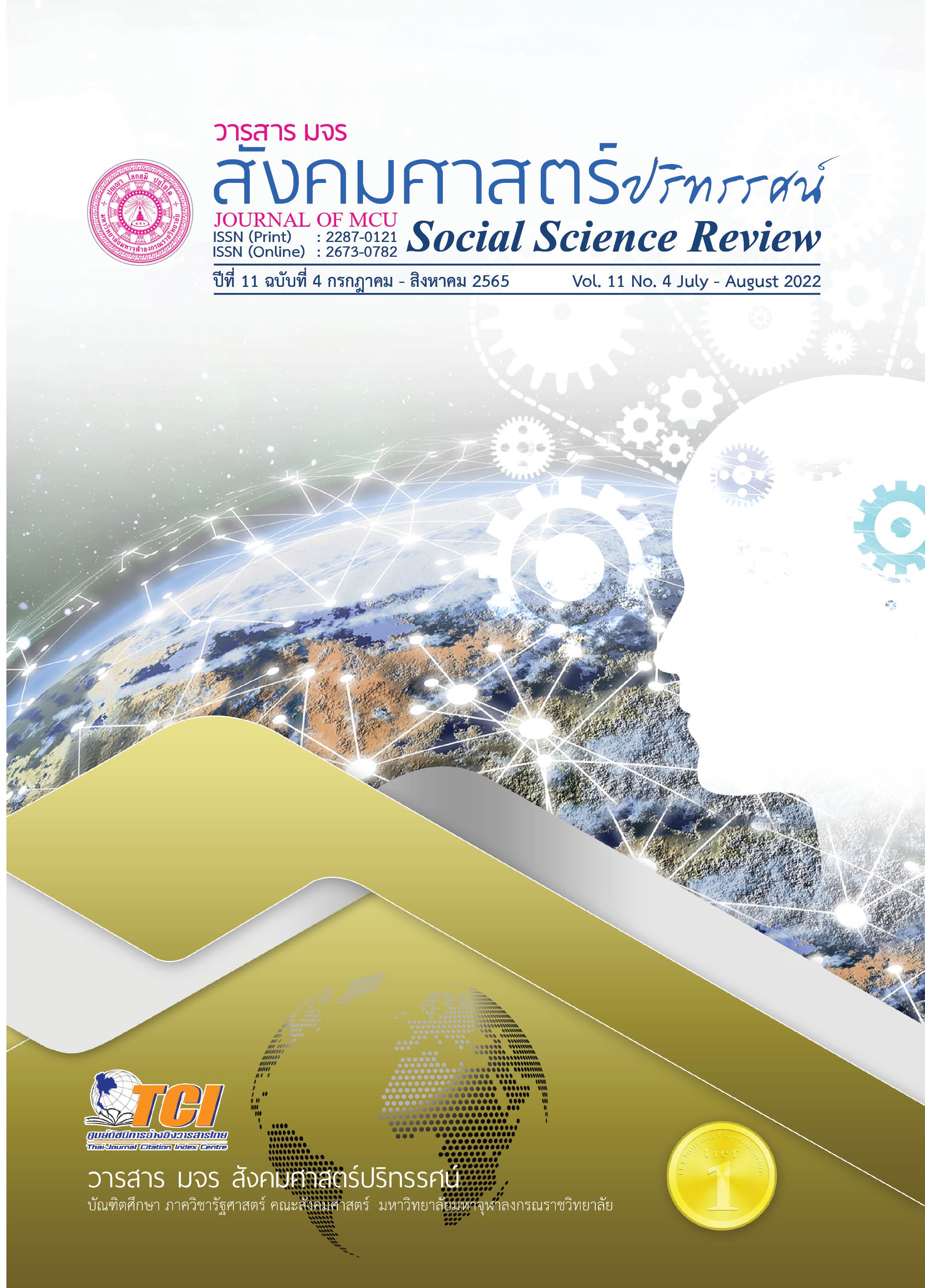การย้ายเมืองหลวงของเมียนมาร์
คำสำคัญ:
เนปิดอว์, ระบบปราการประดิษฐ์, 7 หัวเมืองยุทธศาสตร์ทางทหารบทคัดย่อ
บทความวิจัยนี้มีวัตถุประสงค์เพื่อศึกษาถึงสาเหตุของการย้ายเมืองหลวงของเมียนมาร์ในมิติต่างๆ เป็นการศึกษาเชิงคุณภาพ จาก ตำรา บทความ เอกสารที่เกี่ยวข้องและสัมภาษณ์
ผลการวิจัยพบว่า 1. การสถาปนาศูนย์บัญชาการรบภาคพื้นทวีป มีลักษณะที่โดดเด่นดังนี้ 1) การโดดเด่นในการตั้งรับเชิงลึก แม้ตะวันตกจะเหนือกว่าในด้านศักยภาพและกำลังพล แต่การแสดงชัยชนะขั้นเด็ดขาดทางทหารนั้นต้องเข้ายึดครองเมืองหลวง ซึ่งอยู่ลึกเข้าไปในแผ่นดินย่อมส่งผลดีต่อทหารเมียนมาร์ที่ใช้ยุทธวิธีกองโจรและการป้องกันตามแนวลึก 2) การวางระบบป้องกันการปิดล้อมของฝูงชน โดยการใช้ประโยชน์จากลักษณะทางภูมิรัฐศาสตร์ที่เหมาะสม 3) การมีภูมิรัฐศาสตร์ที่เหมาะสม ประกอบด้วยเทือกเขาและลำน้ำซึ่งยากต่อการรบในแบบ 4) กระบวนการโต้กลับซีกโลกตะวันตก (1) ยุทธศาสตร์การกระจายฝูงชน (2) ปฏิกิริยาโต้กลับทางทหาร 5) การสร้างระบบปราการประดิษฐ์ คือการวางยุทธศาสตร์ทางการทหารเพื่อต่อต้านผู้รุกรานภายนอก 6) การจัดวางระบบ 7 หัวเมืองยุทธศาสตร์ทางทหาร 2. ด้านเศรษฐกิจ พบว่า ลักษณะความอุดมสมบูรณ์ของพื้นที่รอบเมืองเนปิดอว์ เหมาะสมต่อการเกษตรส่งผลให้กองทัพเมียนมาร์นั้นใช้ประโยชน์จากพื้นที่ในการสะสมเสบียงเพื่อใช้ในการรบกับกองกำลังต่างชาติในระยะยาวได้ 3. ด้านวัฒนธรรม พบว่า 1) การลบภาพเมืองหลวงเก่าที่เคยถูกยึดครองโดยอังกฤษ 2) การสถาปนาศูนย์กลางทางจิตวิญญาณใหม่ 3) การรุกคืบทางวัฒนธรรมไปสู่ดินแดนลุ่มน้ำสาละวิน 4) ศาสนาถูกใช้เป็นเครื่องมือเชิงสัญลักษณ์ (1) การมอบตำแหน่งสมณศักดิ์พิเศษคณะสงฆ์ (2) การกลืนทางวัฒนธรรม 5) ผสมผสานทางวัฒนธรรมระหว่างวัฒนธรรมพม่ากับวัฒนธรรมท้องถิ่นตามรัฐต่างๆ
เอกสารอ้างอิง
ชาญวิทย์ เกษตรศิริ. (2544). พม่า: ประวัติศาสตร์และการเมือง (พิมพ์ครั้งที่ 4). กรุงเทพฯ: มูลนิธิโครงการตาราสังคมศาสตร์และมนุษยศาสตร์.
ดุลยภาค ปรีชารัชช. (2555). เนปิดอว์ ปราการเหล็กแห่งกองทัพพม่า. กรุงเทพฯ: โรงพิมพ์แห่งจุฬาลงกรณ์มหาวิทยาลัย
ธนาคารแห่งประเทศไทย. (2564). เมืองหลวงใหม่พม่า “เปียงมนา เนปิดอว์.”. สืบค้น 19 กันยายน 2564, จาก https://shorturl.asia/qDyAi
วรากรณ์ สามโกเศศ. (2548). เมืองหลวงใหม่พม่าเปียงมนา เนปิดอว์. สืบค้น 19 กันยายน 2564, จาก https://shorturl.asia/cW4s2
ศุภวัฒน์ คุณานุวัฒน์. (2552). เนย์ปิดอว์ราชธานีใหม่ของพม่า...และเหตุใดทำไมพม่าจึงย้ายกรุง. สืบค้น 19 กันยายน 2564, จาก https://www.kroobannok.com/blog/22469
เสมอชัย พูลสุวรรณ. (2552). รัฐฉาน (เมืองไต): พลวัตของชาติพันธุ์ในบริบทประวัติศาสตร์และสังคมการเมืองร่วมสมัย. กรุงเทพฯ: มหาวิทยาลัยธรรมศาสตร์.
สุเนตร ชุตินธรานนท์. (2555). ไขคติเบิกยุคของพม่าเหตุย้ายเมืองหลวงไปเนปิดอว์. สืบค้น 19 กันยายน 2564, จาก https://prachatai.com/journal/2012/06/41272
อิมรอน มะลูลีม และสุณัย ผาสุข. (2547). ความมั่นคงและชนกลุ่มน้อยตามแนวชายแดนไทย-พม่า (รายงานวิจัย). กรุงเทพฯ: สำนักงานเลขาธิการวุฒิสภา.
ซอว์ เทว์ เหมี่ยน. (2561, 11 พฤศจิกายน). อธิการบดี Myanmar Creative University [บทสัมภาษณ์].
จอว์ เสว่. (2562, 20 พฤศจิกายน). อดีตอธิการบดีวิทยาลัยทหารเมียนมาร์ [บทสัมภาษณ์].
อิสรัมภ์ ศรียิ่งยงค์. (2562, 20 พฤศจิกายน.) Director of Myanmar Creative University [บทสัมภาษณ์].
จาย วัน (2561, 11 มีนาคม). อดีตครูฝึกทหารรัฐไทใหญ่ [บทสัมภาษณ์].
เซย์ การ์ปาว. (2561, 11 พฤศจิกายน). ผู้ช่วยสอนมหาวิทยาลัย Myanmar Creative University [บทสัมภาษณ์].
ดาวน์โหลด
เผยแพร่แล้ว
รูปแบบการอ้างอิง
ฉบับ
ประเภทบทความ
สัญญาอนุญาต
ลิขสิทธิ์ (c) 2022 วารสาร มจร สังคมศาสตร์ปริทรรศน์

อนุญาตภายใต้เงื่อนไข Creative Commons Attribution-NonCommercial-NoDerivatives 4.0 International License.
เพื่อให้เป็นไปตามกฎหมายลิขสิทธิ์ ผู้นิพนธ์ทุกท่านต้องลงลายมือชื่อในแบบฟอร์มใบมอบลิขสิทธิ์บทความให้แก่วารสารฯ พร้อมกับบทความต้นฉบับที่ได้แก้ไขครั้งสุดท้าย นอกจากนี้ ผู้นิพนธ์ทุกท่านต้องยืนยันว่าบทความต้นฉบับที่ส่งมาตีพิมพ์นั้น ได้ส่งมาตีพิมพ์เฉพาะในวารสาร มจร สังคมศาสตร์ปริทรรศน์ เพียงแห่งเดียวเท่านั้น หากมีการใช้ภาพหรือตารางหรือเนื้อหาอื่นๆ ของผู้นิพนธ์อื่นที่ปรากฏในสิ่งตีพิมพ์อื่นมาแล้ว ผู้นิพนธ์ต้องขออนุญาตเจ้าของลิขสิทธิ์ก่อน พร้อมทั้งแสดงหนังสือที่ได้รับการยินยอมต่อบรรณาธิการ ก่อนที่บทความจะได้รับการตีพิมพ์ หากไม่เป็นไปตามข้อกำหนดเบื้องต้น ทางวารสารจะถอดบทความของท่านออกโดยไม่มีข้อยกเว้นใดๆ ทั้งสิ้น





